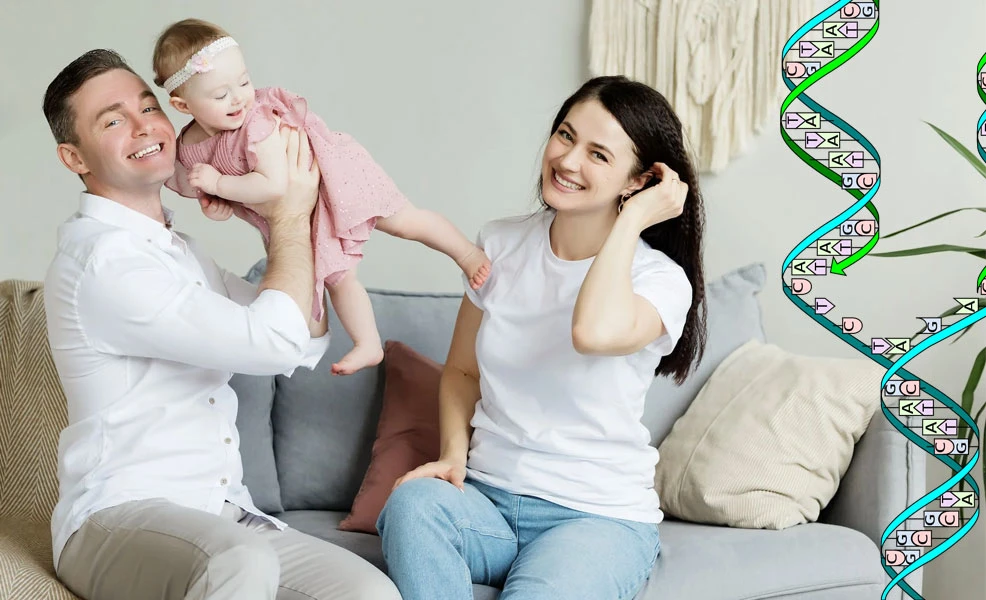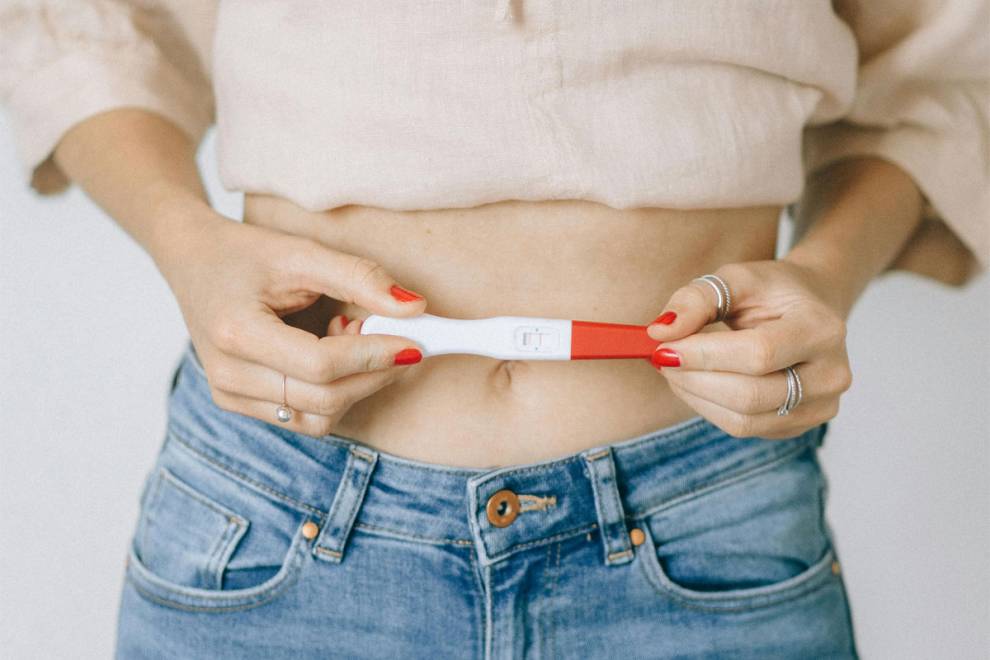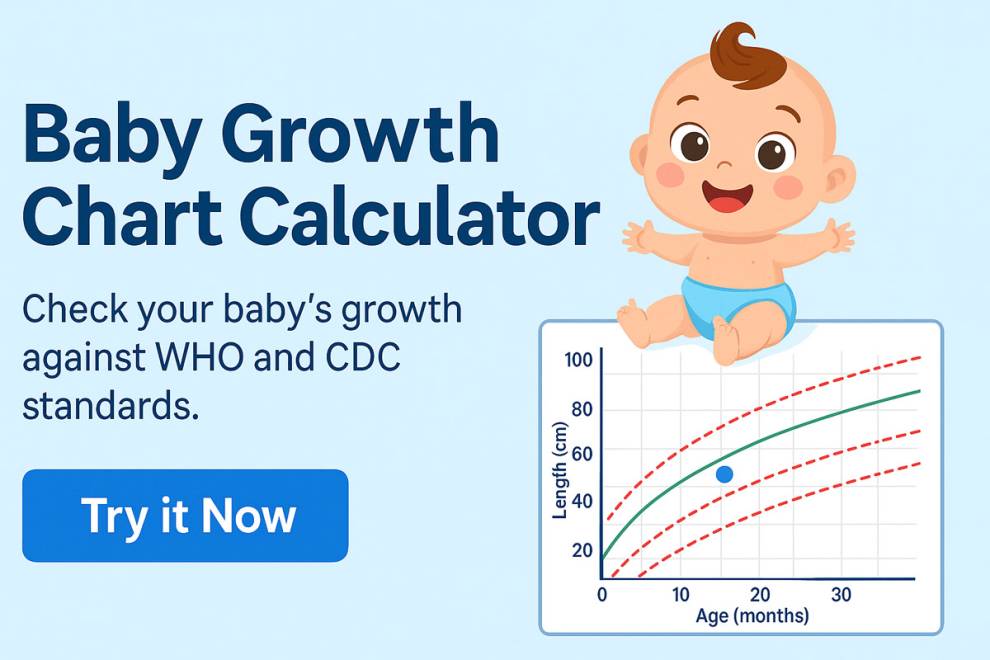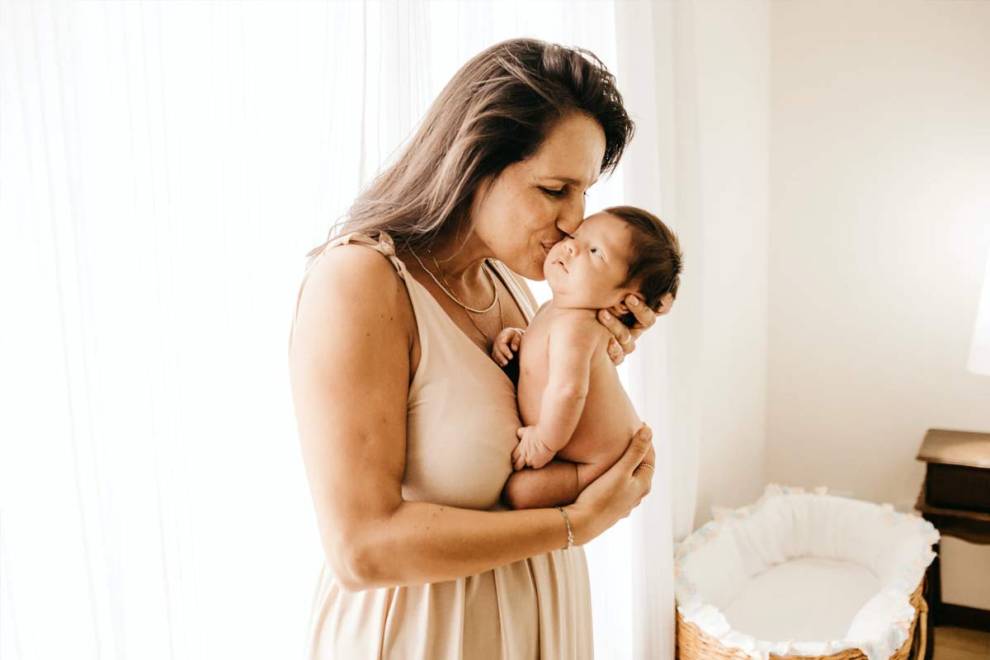Curious what your baby might look like? Try our popular baby genetics calculator!

Mommyhood101 independently tests and curates baby gear to help you make informed decisions. If you buy products through links on our site, we may earn a commission.
Find out what your baby will look like with the most accurate baby genetic calculator available online. Every year, we use new research findings from universities and genetics institutes to update our calculator!
Enter some information about mom and dad and see the results. Scroll down for details on how the calculator works, and how accurate it is.
When you're done, check out our reviews of the best baby products of the year, and our baby name popularity calculator!
Baby Genetic Calculators: Are they Accurate?
All of the genetic calculators available online use classic Mendelian genetics, which identifies patterns in the basic laws of inheritance. In other words, patterns of what mom and dad will pass on to their children.
According to Mendelian genetics, there are many inheritance patterns, including dominant, recessive, and mitochondrial genes that can be passed on from parents to children. These patterns are responsible for basic phenotypes (observable traits) and sometimes disease.
However, while these patterns can make rough predictions of what parents will pass on to their babies, each baby has an average of about 60-70 new genetic mutations compared to their parents. This variation makes it very difficult to predict your baby's eye or hair color, chin cleft, dimples, widow's peak, or height!
Because this is not a sure thing, our calculator provides probabilities alongside all of our estimates. When the probability is lower (less than 75%), it means the calculator is not very confident in its estimate; when the probability is higher (higher than 75%), it means the calculator is more confident in its estimate.
We update the predictions of our calculator, and the corresponding probabilities, on an annual basis - making sure that we tweak the algorithms to account for new research findings. See our scientific resources at the bottom of this page.
Baby Eye Color Calculator
The eye color calculator uses Mendelian genetics to calculate the probability of inheriting certain phenotypes (in this case, eye color) from parents.
By examining combinations of parents' eye colors, the calculator can determine the probability of your baby having blue, green, hazel, or brown eyes.

For example, if both parents have blue eyes, the probability of your baby having blue eyes is approximately 99%, green eyes approximately 1%, and brown eyes nearly impossible.
While our calculator uses parents' eye color, to get even more specific you can use maternal and paternal grandparents' eye colors, but this only changes the probabilities by about 2-5% so it's usually not worth the time. Want your infant car seat to match and bring out their eye color? Go with the odds!
Eye color is largely determined by two major genes: OCA2 and HERC2, which are predictive of brown or blue eyes. About 8 other genes also contribute in relatively minor ways, and are predictive of eye colors like green and hazel (they are also predictive of hair color and skin color).
What Color Eyes Will My Baby Have?
It is hard to predict exactly what color eyes your baby will have, but we guarantee they will be absolutely beautiful! Use our baby eye color calculator to make a prediction!
Scientists used to think that if both parents had blue eyes, it was impossible for their baby to have brown eyes. More recent research shows this traditional view is incorrect, and it's a much more complex genetic interaction that dictates eye color.
The color of your baby's iris (the colored ring surrounding the dark pupils) is determined by the amount of two pigments in their eyes: melanin and lipochrome. These pigments serve to darken the iris: the more melanin your eyes have, the darker they will be. The more lipochrome your eyes have, the more likely they will be green (or even have some gold tones!).
Eyes with less melanin tend to be light blue or green. Eyes with more melanin tend to be darker, such as dark blues or browns.
Because about 10 different genes interact to determine eye color, it is very difficult to accurately predict!
Does Mom or Dad's Eye Color Matter More?
When it comes to predicting what color your baby's eyes will be, it actually doesn't matter which parent has which eye color. Mom and dad contribute equally to a baby's eye color.
That is because the 10 different genes that interact to determine eye color are not found on a sex chromosome. If they were, that would be a different story!
Are Brown Eyes Dominant?
While brown eyes are the most common worldwide (about 75% of all people!), they are not dominant in a genetic sense. In fact, there is no dominant eye color.
Can Blue-Eyed Parents have a Brown-Eyed Baby?
Absolutely! Decades ago, scientists used to believe that parents with blue eyes (both mom and dad) could not have a baby with brown eyes.
More recent research shows that this is definitely possible, though it is definitely rare (about 1% of the time)!
Can Brown-Eyed Parents have a Blue-Eyed Baby?
Absolutely! While it is not very likely for brown-eyed parents to have a blue-eyed baby, it's definitely possible!
What is the Most Common Eye Color in Babies and Adults?
Babies tend to have lighter color eyes (blue, grey, green, hazel) that darken over time. Brown eyes are the most common worldwide in adults, occurring in about 75% of people according to research.
Different regions of the world tend to have different eye color patterns. For example, while brown eyes are extremely common in Asia, South America, and Africa, they are less common in western and northern Europe.
When do Baby's Eyes Stop Changing Color?
Most babies, especially of European descent, are born with greyish or blue eyes.
However, most babies show a darkening iris over time, due to the eye and skin's natural melanin response to ultraviolet light. This process happens around the first 6-9 months of life, and the eyes are usually done changing color by 12 months of age.
How much melanin gets produced (and therefore how dark the eyes become) is dictated by the number and activity level of melanin-producing cells in the eyes (melanocytes).
Are Baby Blue Eyes the Most Attractive?
Not necessarily, most studies show that eye color is not as important as stereotypes suggest.
Several studies have attempted to identify whether blue, green, hazel, grey, or brown eyes are the most attractive.
As it turns out, men with blue eyes tend to prefer women with that same eye color. Women, however, do not show strong eye color preferences.
In addition to eyes, there are several other more important factors that research shows are important for determining whether someone is perceived as attractive. These include facial symmetry, skin quality, the position and shape of eyebrows, eyelashes, pupil diameter, and the whiteness of the eye's perimeter!
Can Baby Eyes be Multiple Colors?
Yes! The tiny cells (melanocytes) that release the pigment (melanin) that colors the eyes can be irregularly distributed throughout the iris. Remember we said that each baby has about 60-70 new genetic mutations? This is one of them!
Do All Babies Actually Have Brown Eyes?
Technically speaking, everyone has melanin in their eyes, which is a brownish pigment. So there is some brown in everyone's eyes!
However, the way that light scatters when it enters the iris can cause the illusion that the eye color is nearly any color! That is why eyes can look very different colors in different lighting conditions.
What Are the Hardest Baby Eye Colors to Predict?
In general, no eye color is easy to predict other than both parents having blue eyes (which predicts a blue-eyed baby about 99% of the time)! I would take those odds any day!
But certain eye colors are actually midway between other colors, making them harder to predict. For example, hazel eyes are intermediate between brown and green eyes.
Not only is it hard to predict if your baby will have hazel eyes, it also makes prediction difficult if parents have hazel eyes.
For example, while I have light blue eyes, my husband has hazel eyes: one of our children has dark brown eyes, and the other has blue eyes! Hazel eyes are the genetic wild card!
Baby Hair Color Calculator
A little more complex than eye color, hair color is controlled by many more genes than eye color and can be challenging to predict.
If both parents have the same hair color, there is an overwhelming (like 95%+) chance that the baby will have that hair color. However, when parents have different hair colors, prediction gets a little tricky!
And when you throw in that red-hair genetic wild card that can sneak up and surprise you (especially if red hair runs in your family), all bets are off!
What Color Hair Will My Baby Have?
Just like eye color, you cannot predict hair color with 100% certainty, but you can make pretty good guesses!
For example, if both parents have brown hair the probability of your parents having brown hair is about 99%. It is possible, however, for your baby to have blonde or red hair as well, especially if either of those hair colors runs in your family. Want the trim on your baby stroller to bring out their hair color? Go with the odds!

While our baby hair color predictor tells you the most likely hair color your baby will have, realize that there are also other colors that carry a lower percentage.
How is Hair Color Determined?
Just like eye color, the pigment melanin (specifically eumelanin) plays an important role in determining hair color.
If you have very little eumelanin, your hair will be more on the blonde side of the spectrum. Increasing levels of eumelanin will shift your hair more towards brown or black hair.
A separate melanin pigment, called pheomelanin, is responsible for producing red hair. Interestingly, red hair is linked to a specific gene mutation (MCR1) that tends to be passed on from parents to children, and includes not only red hair but also freckles and sun sensitivity (check out our reviews of baby sunscreen!).
Does Mom or Dad's Hair Color Matter More?
Just like eye color, hair color is not determined more by one parent versus another. Mom and dad contribute equally to the baby's hair color.
That is because the 50-100 different genes that interact to determine hair color are not found on a sex chromosome. If they were, that would be a different story!
Is Brown Hair Dominant?
No, brown hair is not dominant, nor is blonde hair. No hair color is definitively dominant because so many (about 50-100!) genes are involved in determining hair color.
When is Baby's Hair Color Final?
Hair color and texture can change a lot during the first several years of a child's life. In general, your child's hair color is final by about the age of 5-7 years old.
Infants' hair tends to be lighter in color because melanin production has not yet ramped up, and will become darker over the first several months of life. However, as infants become toddlers, their hair tends to lighten again as they grow older.
Of course, your child's hair may stay exactly the same from birth to adulthood! Throughout adulthood, however, lighter hair tends to darken. It is very rare to see a naturally blonde or red-headed adult.
Can You Predict if My Baby Will Have Curly Hair?
You will notice that our hair color calculator does not have a variable to help predict whether your baby will have straight, wavy, or curly hair.
Whether hair is relatively straight or curly is inherited, but it's determined by what is called an additive trait: the number of gene variations you pass along to your child predicts the amount of curliness of your child's hair. Interestingly, curly hair is caused by the shape of your hair follicles: perfectly round follicles grow straight hair, while more ovular follicles grow increasingly curly hair.
Of course, parents may not pass along all of their hair type genes, or these can be mutated in the process. For that reason, a child of curly-haired parents can have straight hair, and vice-versa.
Baby Cleft Chin Calculator
A cleft chin occurs when there is a visible dimple or fissure in the middle of the chin, dividing it into two halves. Some cleft chins are very subtle and resemble a small dimple, whereas some cleft chins have a much more pronounced indentation.

While most people (over 90% of all people) do not have a cleft chin, some parents wonder whether their baby will inherit a cleft chin from their parents.
Will My Baby Have a Cleft Chin?
If both parents have a cleft chin, the odds of your baby having a cleft chin are about 90%. If both parents have no cleft chin, the odds of your baby having a cleft chin are about 1%.
However, if one parent has a cleft chin and the other does not, it is relatively challenging to predict what your baby will have. In that case, the odds are that your baby will have a cleft chin (about 67% chance), but still a reasonable chance (about 33%) that they will not.
What Causes a Cleft Chin?
The mandibular bone typically fuses together in utero, somewhere around the second trimester or third trimester of pregnancy. If the mandibular bone does not fuse completely, there is a fissure in the bone that your chin will conform to, causing a cleft chin.
While scientists used to believe that a chin cleft was dominant or recessive, more recent research suggests that it's more complex than that.
Specifically, because parents without cleft chins can have children without clefted chins, it is now thought that cleft chin is not determined by a single gene or dominant allele.
To our knowledge, this question is still debated; in the meantime, we know that the cleft chin resides on chromosome 5, and that some believe it is autosomal dominant, whereas some scientists do not.
Is a Cleft Chin Attractive?
To our knowledge, no high-quality studies have answered this question.
Some believe that a cleft chin contributes to a more dominant masculine face, whereas some other research suggests that chin dimples are non-preferred.
Baby Dimples Calculator
Dimples are adorable little indentations on the cheeks that become more pronounced while smiling.

Most people (about 85%) do not have dimples, but others have one or both. In fact, of people with dimples, research shows that more tend to have a dimple one side (unilateral dimples) than both sides (bilateral dimples).
What Causes Dimples?
Very little research has been conducted to determine exactly what causes dimples, though it appears to be caused by a genetic mutation that shortens certain facial muscles.
There is a common myth that dimples might be determined by a single gene, but there is no compelling research to suggest this is true.
Given that dimples can appear or disappear during development, such as a baby with dimples that loses them as an adult, it is challenging to classify people as having or not having dimples, and even more challenging to identify their patterns of inheritance.
Will My Baby Have Dimples?
If both parents have dimples, the odds are in your favor (over 50%) that your baby will also have dimples.
If neither parent has dimples, the odds are extremely low (about 1% or less) that your baby will have dimples.
If one parent has dimples and one does not, the chances of your baby having dimples are about 67%. Not bad!
Are Dimples Attractive?
Dimples have a long history of being associated with cuteness, flirtatiousness, and fun, especially in literature and film. However, our search of the scientific literature found no compelling evidence that dimples are reliably linked to perceptions of attractiveness. An honor's thesis waiting to happen!
Just like people use colored contact lenses to change their eye color, and hair dyes to change hair color, some people opt for plastic surgery to cause dimples on their cheeks.
Baby Earlobe Type Calculator
Earlobes come in all shapes and sizes, just like every other part of your beautiful little one!
Predicting earlobe phenotypes from hereditary patterns is difficult, just like with eye color and hair color.
Overall, you can predict with up to 85-90% confidence if both parents have the same ear types, but those probabilities drop off pretty quickly if parents have different earlobe shapes.
Attached Versus Detached Earlobes
Our baby feature calculator considers two specific types of ear features: attached earlobes versus detached earlobes. The primary difference is the attachment point where the earlobe attaches to the face.
Attached earlobes do not hang down before attaching to the face near the jaw line, instead they follow a rounded bend and attach immediately to the face without any dangling earlobe.
Detached earlobes hang down before attaching to the face near the jawline, following a hook-shaped contour that causes them to dangle down.
In technical jargon, the distance between the otobasion inferius (where the lobe attaches to the face) and the subaurale (the lowest point of the earlobe) determines the extent of detachment, with higher distances indicating more detachment. In this manner, there is no true categorical classification of attached versus detached, but rather a continuum. Parents and babies all fall somewhere along this continuum.
But jargon aside, the best way to recognize an attached versus detached earlobe is with a photo!

Notice how the detached earlobe is easily delineated from the rest of the ear, whereas the attached earlobe is less distinguished from the rest of the outer ear structure.
What Determines Earlobe Shape?
Early scientists believed attached earlobes were a dominant trait (in the 1920's), then believed attached earlobes were a recessive trait (in the 1930's).
Over the next several decades, scientists realized that earlobe shape was determined either by more than one gene or a single gene with greater than two alleles.
After about 100 years of research into earlobe shape, research now suggests that earlobe shape is determined by about 50 genes! This makes it more difficult to predict, but is also a more accurate characterization of how earlobes shape is inherited.
Which Earlobe Shape is Better?
Neither earlobe shape, attached or detached, is better in any way. One will not help you hear better than the other.
Some people find one earlobe shape more attractive than the other.
In general, research suggests that people find a slightly detached earlobe the most attractive, with completely attached (no clear lobe delineation) and highly detached (hanging very low) earlobes to be less attractive. This applies to both men and women.
There is also no dominant ear shape since it is determined by about 50 different genes.
Baby Widow's Peak Calculator
A widow's peak is a prominent v-shaped dip in the hairline at the center of the forehead.

The unfortunate name comes from old myths that women with a widow's peak would become a widow sooner than others. There is no truth to this, of course!
What Causes a Widow's Peak?
Nobody really knows for sure what causes a widow's peak to form, or what causes it to be more pronounced in some cases than others.
Some research suggests that a pointed frontal hairline is more likely to occur when there is more distance between the eyes (hypertelorism), with a receding hairline (during aging), and it can also occur due to rare genetic disorders (Aarskog syndrome, Opitz-Frais syndrome, and others).
It is likely that widow's peaks are caused by multiple genes rather than a single dominant gene, but frankly, that research simply hasn't been done.
Will My Baby Have a Widow's Peak?
Just like with other features, it is hard to predict whether your baby will have a widow's peak. This is because there are likely multiple genes involved, and there has been very little research done on the topic.
Is a Widow's Peak Attractive?
Distinctive widow's peaks are often portrayed as evil, villainous, or sinister in films, such as seen with Dracula's and the Joker's prominent widow's peaks. However, in real life they are perceived as normal hairline variation.
Whether they are attractive is largely a matter of personal preference. Some people really like the look of a widow's peak, whereas some do not. Of course, some widow's peaks are more pronounced and noticeable than others, which can change people's preferences.
Some examples of famous people with widow's peaks include Leonardo DiCaprio, John Travolta, Keanu Reeves, Blake Lively, Grace Kelly, and Marilyn Monroe. If your baby has a widow's peak, he or she is in good company!
Baby Height Calculator
Many parents are interested in knowing whether their baby will be a towering basketball player, an adorable petite ballerina, or somewhere in between.
When will you need to adjust the height of their crib mattress, switch to a convertible car seat, or switch from a bassinet to crib? Their height is an important factor for all of these transitions!
People vary dramatically in height, and this is widely distributed across the world with some regions showing generally shorter populations (such as Southeast Asia, Greenland, India, and Saudi Arabia) or generally taller populations (such as Norway, Sweden, Finland, Australia, and North America).
In general, people tend to be getting taller over time, especially males, likely due to patterns of sexual selection.
Our calculator predicts your baby's height based on information about parent's height, provided in either feet and inches or centimeters.
What Determines a Baby's Height?
Research into the genetics of height is some of the best-established genetics research in history, and is pretty well-defined.
In general, the heritability of height is about 80%, which is quite a bit higher than other phenotypes (traits) that you will try to predict in your baby!
Over the past few decades and since the Human Genome Project completed in 2003, scientists have identified literally hundreds of gene variants that interact to predict height (this is called a highly polygenic trait).
How Tall Will My Baby Be?
In general, children of taller parents will be taller, and children of shorter parents will be shorter! That shouldn't be so surprising, but of course there are always exceptions to this pattern. Some shorter parents end up with children much taller than them, and vice-versa!
Because so much research has been done linking height to genetics and heritability, our calculator can do a pretty decent job of predicting height. But there will always be some uncertainty surrounding any phenotype prediction, and height is no exception.
Why Calculate your Baby's Features?
You might be wondering why in the world parents would be interested in predicting their baby's height and facial features!
First and foremost, it's fun! Even early during pregnancy you can begin conjuring up images of what your baby might look like, combining your and your partner's traits!
Second, many parents like to think about what their baby could look like before they pick a name. Be sure to check out our huge lists of baby boy names and baby girl names!
Third, some parents like to place fun bets on what feature their baby will have, and even do so with extended family. Think March Madness, with a hint of genetics!
Whatever your reasons, we hope you enjoy the Mommyhood101 baby calculator!
Scientific References
Strome, S., Bhalla, N., Kamakaka, R., Sharma, U., & Sullivan, W. (2024). Clarifying Mendelian vs non-Mendelian inheritance. Genetics, iyae078.
Erbilgin, Y., & Sayitoglu, M. (2025). The Human Genome and Inheritance: Key Concepts. Pathological Basis of Oral and Maxillofacial Diseases, 227-244.
Walsh, S., & Kayser, M. (2023). Prediction of Physical Characteristics, such as Eye, Hair, and Skin Color, Based Solely on DNA. Forensic DNA Applications: An Interdisciplinary Perspective, 357.
Brancato, D., Coniglio, E., Bruno, F., Agostini, V., Saccone, S., & Federico, C. (2023). Forensic DNA Phenotyping: Genes and Genetic Variants for Eye Color Prediction. Genes, 14(8), 1604.
Cabrejas-Olalla, A., Jørgensen, F. G., Cheng, J. Y., Kjærgaard, P. C., Schierup, M. H., Mailund, T., & Athanasiadis, G. (2025). Genetic predictions of eye and hair colour in the Danish population. Forensic Science International: Genetics, 78, 103267.
Sasani, T. A., Pedersen, B. S., Gao, Z., Baird, L., Przeworski, M., Jorde, L. B., & Quinlan, A. R. (2019). Large, three-generation human families reveal post-zygotic mosaicism and variability in germline mutation accumulation. Elife, 8, e46922, 8, e46922.
Conrad, D. F., Keebler, J. E., DePristo, M. A., Lindsay, S. J., Zhang, Y., Casals, F., ... & 1000 Genomes Project. (2011). Variation in genome-wide mutation rates within and between human families. Nature genetics, 43(7), 712, 43(7), 712.
Sturm, R. A., & Larsson, M. (2009). Genetics of human iris colour and patterns. Pigment cell & melanoma research, 22(5), 544-562, 22(5), 544-562.
Matheny Jr, A. P., & Dolan, A. B. (1975). Sex and genetic differences in hair color changes during early childhood. American journal of physical anthropology, 42(1), 53-56, 42(1), 53-56.
Sturm, R. A., Duffy, D. L., Zhao, Z. Z., Leite, F. P., Stark, M. S., Hayward, N. K., ... & Montgomery, G. W. (2008). A single SNP in an evolutionary conserved region within intron 86 of the HERC2 gene determines human blue-brown eye color. The American Journal of Human Genetics, 82(2), 424-431, 82(2), 424-431.
Laeng, B., Mathisen, R., & Johnsen, J. A. (2007). Why do blue-eyed men prefer women with the same eye color? Behavioral Ecology and Sociobiology, 61(3), 371-384, 61(3), 371-384.
Gründl, M., Knoll, S., Eisenmann-Klein, M., & Prantl, L. (2012). The blue-eyes stereotype: do eye color, pupil diameter, and scleral color affect attractiveness?. Aesthetic plastic surgery, 36(2), 234-240, 36(2), 234-240.
Rees, J. L. (2003). Genetics of hair and skin color. Annual review of genetics, 37(1), 67-90, 37(1), 67-90.
Branicki, W., Liu, F., van Duijn, K., Draus-Barini, J., Pośpiech, E., Walsh, S., ... & Kayser, M. (2011). Model-based prediction of human hair color using DNA variants. Human genetics, 129(4), 443-454, 129(4), 443-454.
Mowlavi, A., Meldrum, D. G., Wilhelmi, B. J., Ghavami, A., & Zook, E. G. (2003). The aesthetic earlobe: classification of lobule ptosis on the basis of a survey of North American Caucasians. Plastic and reconstructive surgery, 112(1), 266-272, 112(1), 266-272.
Shaffer, J. R., Li, J., Lee, M. K., Roosenboom, J., Orlova, E., Adhikari, K., ... & Weinberg, S. M. (2017). Multiethnic GWAS reveals polygenic architecture of earlobe attachment. The American Journal of Human Genetics, 101(6), 913-924, 101(6), 913-924.
Tamir, A. (2013). Numerical survey of the different shapes of human chin. Journal of Craniofacial Surgery, 24(5), 1657-1659, 24(5), 1657-1659.
Lebow, M. R., & Sawin, P. B. (1941). Inheritance of human facial features: a pedigree study involving length of face, prominent ears and chin cleft. Journal of Heredity, 32(4), 127-132, 32(4), 127-132.
Wiedemann, H. R. (1990). Cheek dimples. American journal of medical genetics, 36(3), 36(3).
Pessa, J. E., Zadoo, V. P., Garza, P. A., Adrian Jr, E. K., Dewitt, A. I., & Garza, J. R. (1998). Double or bifid zygomaticus major muscle: anatomy, incidence, and clinical correlation. Clinical Anatomy: The Official Journal of the American Association of Clinical Anatomists and the British Association of Clinical Anatomists, 11(5), 310-313, 11(5), 310-313.
Smith, D., & Cohen, M. M. (1973). Widow's peak scalp-hair anomaly and its relation to ocular hypertelorism. The Lancet, 302(7838), 1127-1128, 302(7838), 1127-1128.
Perola, M., Sammalisto, S., Hiekkalinna, T., Martin, N. G., Visscher, P. M., Montgomery, G. W., ... & Peltonen, L. (2007). Combined genome scans for body stature in 6,602 European twins: evidence for common Caucasian loci. PLoS Genet, 3(6), e97, 3(6), e97.
Silventoinen, K., Sammalisto, S., Perola, M., Boomsma, D. I., Cornes, B. K., Davis, C., ... & Kaprio, J. (2003). Heritability of adult body height: a comparative study of twin cohorts in eight countries. Twin Research and Human Genetics, 6(5), 399-408, 6(5), 399-408.
Yang, J., Benyamin, B., McEvoy, B. P., Gordon, S., Henders, A. K., Nyholt, D. R., ... & Visscher, P. M. (2010). Common SNPs explain a large proportion of the heritability for human height. Nature genetics, 42(7), 565-569, 42(7), 565-569.
Allen, H. L., Estrada, K., Lettre, G., Berndt, S. I., Weedon, M. N., Rivadeneira, F., ... & Pietiläinen, K. H. (2010). Hundreds of variants clustered in genomic loci and biological pathways affect human height. Nature, 467(7317), 832-838, 467(7317), 832-838.
Stulp, G., & Barrett, L. (2016). Evolutionary perspectives on human height variation. Biological Reviews, 91(1), 206-234, 91(1), 206-234.










